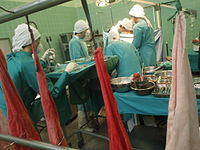
Photo from wikipedia
ABSTRACT Background Unilateral nephrectomy is a relatively common procedure in children which results in a solitary functioning kidney (SFK). Living with an SFK predisposes to kidney injury, but it remains… Click to show full abstract
ABSTRACT Background Unilateral nephrectomy is a relatively common procedure in children which results in a solitary functioning kidney (SFK). Living with an SFK predisposes to kidney injury, but it remains unknown which children are most at risk. We aimed to investigate kidney injury rates in patients who underwent unilateral nephrectomy in childhood and to investigate differences among nephrectomies performed for a congenital anomaly, malignancy or other condition. Methods MEDLINE and EMBASE were searched for studies reporting kidney injury rates [i.e. proteinuria, hypertension and/or a decreased glomerular filtration rate (GFR)] of patients who underwent unilateral nephrectomy during childhood. Studies including five or more patients with at least 12 months of follow-up were eligible. Analyses were performed using random effects models and stratified by indication for nephrectomy. Preferred Reporting Items for Systematic Reviews and Meta-Analyses (PRISMA) and Meta-analysis Of Observational Studies in Epidemiology (MOOSE) guidelines were used for reporting. Results Over 5000 unique articles were screened, of which 53 studies reporting on >4000 patients were included in the analyses. Proteinuria, hypertension and a decreased GFR were present in 15.3, 14.5 and 11.9% of patients, respectively. Heterogeneity among the studies was large in several subgroups, impairing quantitative meta-analyses. However, none of our analyses indicated differences in injury rates between a congenital anomaly or malignancy as an indication for nephrectomy. Conclusions Unilateral nephrectomy during childhood results in signs of kidney injury in >10% of patients, with no clear difference between the indications for nephrectomy. Therefore, structured follow-up is necessary in all children who underwent nephrectomy, regardless of the indication.
Journal Title: Nephrology Dialysis Transplantation
Year Published: 2022
Link to full text (if available)
Share on Social Media: Sign Up to like & get
recommendations!